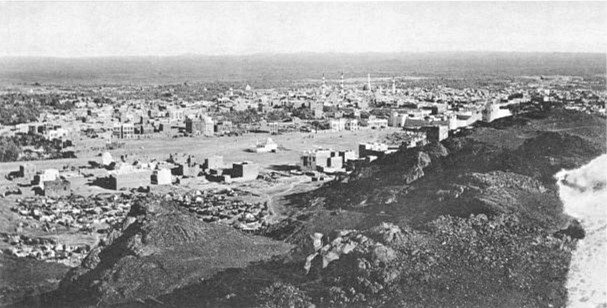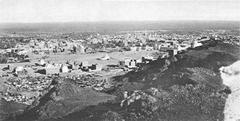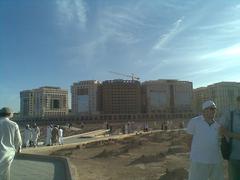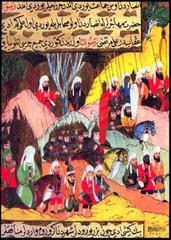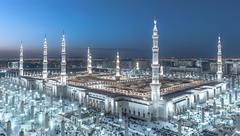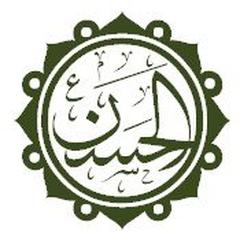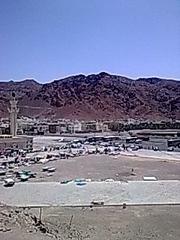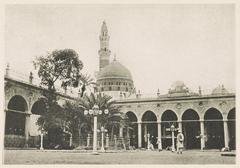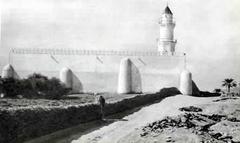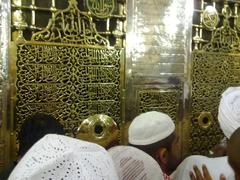Sela Jabal Sela Medina Visiting Hours, Tickets, and Historical Sites Guide
Date: 14/06/2025
Introduction to Sela Jabal Sela Medina and Its Significance
Nestled in the heart of Medina, Saudi Arabia, Mount Selaʾ (Arabic: سلع)—also known as Sela Mountain or Jabal Selaʾ—is a landmark of profound religious, historical, and cultural significance. Its distinctive “sliced” silhouette makes it an unmistakable feature of the city’s landscape. More importantly, Mount Selaʾ is intimately connected with early Islamic history and the life of the Prophet Muhammad ﷺ. Its elevated vantage point within the District of the Seven Mosques offers panoramic views of Medina and stands as a spiritual beacon commemorated in pivotal Islamic events, such as the Battle of the Trench (Ghazwat al-Khandaq) in 627 CE, when the Prophet prayed atop the mountain seeking divine guidance (dbpedia.org; Wikipedia).
Beyond its strategic role in early Islam, Mount Selaʾ is revered for its association with religious practices like the Prayer for Rain (Salat al-Istisqaʾ) and the story of the forgiveness of Kaʿb bin Mālik. Its layers of historical and spiritual meaning have transformed it into a site of pilgrimage and reflection, complementing Medina’s tapestry of sacred landmarks such as Al-Masjid an-Nabawi and the Seven Mosques (wanderlog.com).
This guide equips travelers, pilgrims, and history enthusiasts with essential information for visiting Mount Selaʾ—covering practical details such as visiting hours, accessibility, and nearby attractions—while also offering insights into its cultural heritage, conservation efforts, and visitor etiquette. Whether you wish to immerse yourself in Islamic history or explore Medina’s unique landscape, understanding Mount Selaʾ’s significance will enrich your journey (Visit Al Madinah; Against the Compass).
Contents
- Introduction
- Origins and Etymology of Mount Selaʾ
- Pre-Islamic Context and Geographic Setting
- Mount Selaʾ in Early Islamic History
- The Hijra and Transformation of Yathrib
- The Battle of the Trench (Ghazwat al-Khandaq)
- Other Notable Events and Hadith References
- Religious and Cultural Significance
- Symbolism in Islamic Tradition
- Integration into Medina’s Urban and Spiritual Landscape
- Visiting Mount Selaʾ: Practical Information
- Visiting Hours
- Tickets and Entry Fees
- Accessibility
- Guided Tours and Special Events
- Nearby Attractions
- Climate and Best Time to Visit
- Access and Transportation
- Visitor Facilities and Practical Information
- Cultural and Religious Considerations
- Travel Tips
- Visitor Experience and Activities
- Conservation and Sustainable Tourism
- Frequently Asked Questions (FAQ)
- Conclusion
Origins and Etymology of Mount Selaʾ
The name Mount Selaʾ derives from the Arabic word meaning “sliced,” referencing the mountain’s distinct, segmented appearance (dbpedia.org). Its unique geological structure makes it a notable landmark within Medina, easily recognizable from various vantage points in the city.
Pre-Islamic Context and Geographic Setting
Prior to Islam, Medina (then Yathrib) was a flourishing oasis inhabited by Arab and Jewish tribes, renowned for its date palms and trading prosperity (medium.com). Mount Selaʾ, located near the city’s center, served as a natural point of reference and possibly as a lookout due to its elevation.
Mount Selaʾ in Early Islamic History
The Hijra and Transformation of Yathrib
The migration (Hijra) of the Prophet Muhammad ﷺ to Yathrib in 622 CE marked the founding of the first Islamic state. Mount Selaʾ became intertwined with this era, witnessing the transformation of Yathrib into Medina—the “Radiant City” (medium.com).
The Battle of the Trench (Ghazwat al-Khandaq)
During the Battle of the Trench in 627 CE, Mount Selaʾ played a strategic role. The Prophet Muhammad ﷺ prayed atop the mountain as Muslims dug a defensive trench to protect Medina from a confederation of Meccan tribes (dbpedia.org). This event solidified Mount Selaʾ’s symbolic status as a site of faith and resilience.
Other Notable Events and Hadith References
- Prayer for Rain (Salat al-Istisqaʾ): The Prophet performed special prayers for rain on Mount Selaʾ during droughts.
- Forgiveness of Kaʿb bin Mālik: The mountain is mentioned in the story of Kaʿb bin Mālik’s forgiveness after missing the Battle of Tabuk (dbpedia.org).
These narratives have contributed to Mount Selaʾ’s enduring spiritual significance.
Religious and Cultural Significance
Symbolism in Islamic Tradition
Mount Selaʾ’s links to the Prophet and pivotal Islamic events make it a revered pilgrimage site. Its proximity to Al-Masjid an-Nabawi and the Seven Mosques enhances its spiritual value, often featuring in itineraries for pilgrims visiting Medina (wanderlog.com).
Integration into Medina’s Urban and Spiritual Landscape
Located in the District of the Seven Mosques, Mount Selaʾ is part of a cluster of sites commemorating the Battle of the Trench and other landmark moments (dbpedia.org). It serves as a bridge between Medina’s ancient past and its modern urban identity.
Visiting Mount Selaʾ: Practical Information
Visiting Hours
- General Hours: Open daily, typically from 8:00 AM to 6:00 PM. Hours may change during religious holidays or special events. Always confirm with local tourism sources for current timings.
Tickets and Entry Fees
- Entry: Free of charge. There is no entrance fee to visit Mount Selaʾ. Guided tours may carry separate fees.
Accessibility
- Location: Accessible by foot or taxi from central Medina.
- Terrain: Moderate uphill walking required. Some pathways are maintained, but visitors with mobility challenges should consult guides for assistance.
Guided Tours and Special Events
- Local tour operators offer guided visits, often including Mount Selaʾ alongside other historical sites such as Quba Mosque and Mount Uhud.
- Occasional events, especially commemorating the Battle of the Trench, are held at the site.
Nearby Attractions
- Al-Masjid an-Nabawi: The Prophet’s Mosque, Islam’s second holiest site.
- The Seven Mosques: Historic mosques linked to the Battle of the Trench.
- Mount Uhud: Site of another key battle in Islamic history.
Climate and Best Time to Visit
- Climate: Medina has a hot desert climate. Summer (May–September) temperatures exceed 40°C (104°F), while winter (November–February) is milder and more pleasant (Against the Compass).
- Best Time to Visit: November to February for comfortable outdoor exploration.
Access and Transportation
- By Air: Prince Mohammad bin Abdulaziz International Airport (MED), about 20 km from central Medina.
- By Train: Haramain High-Speed Railway connects Medina to Mecca, Jeddah, and King Abdullah Economic City.
- By Road: Well-developed highways link Medina to other regions.
- Local Transport: Taxis, ride-hailing apps (Uber, Careem), and limited public transport are available. Walking from Al-Masjid an-Nabawi takes about 20–30 minutes (Trek Zone).
Visitor Facilities and Practical Information
- Restrooms: Available in nearby mosques and commercial areas.
- Shops and Food: Small shops and cafes are nearby.
- Parking: Street parking is limited, especially during pilgrimage seasons.
- Dress Code: Modest attire is required; arms and legs should be covered. Women are not legally required to wear abayas but should dress modestly (CN Traveller ME).
- Safety: Medina is generally safe, but visitors should remain vigilant and respect local customs (Alternative Airlines).
- Health: Bring water, sunscreen, and a hat, and consider travel insurance (Against the Compass).
Visitor Experience and Activities
- Hiking and Nature Walks: Enjoy scenic trails with panoramic city views.
- Historical Exploration: Visit caves and sites associated with the Prophet’s prayers and retreats (3Rooj).
- Photography: Capture the mountain’s unique “sliced” formation and cityscape.
- Cultural Tours: Join guided tours to deepen your understanding of the site.
Inclusivity
Unlike Mecca, which restricts non-Muslim access, Medina—particularly sites like Mount Selaʾ—is open to visitors of all backgrounds, though some central religious sites remain restricted (Besides the Obvious). All visitors should dress modestly and observe etiquette during religious events and prayer times.
Conservation Efforts and Sustainable Tourism
- Urban Protection: Local authorities have implemented zoning and conservation measures to protect Mount Selaʾ from urban expansion (3Rooj).
- Sustainable Tourism: Guided tours, educational programs, and interpretive signage promote awareness and stewardship (Hiking Saudi Arabia).
- Vision 2030: Medina’s tourism initiatives align with Saudi Arabia’s Vision 2030, emphasizing eco-friendly accommodations and support for local communities (Mondaq).
Cultural and Religious Considerations
- Dress Modestly: Cover shoulders and knees. Women should dress modestly; hijab is not required for visitors (David Travels).
- Etiquette: Use your right hand for greetings, avoid physical contact between unrelated men and women, and seek permission before photographing people.
- Behavior: Respect prayer times and avoid loud conversation near mosques.
- Language: Arabic is official; English is widely understood in hotels and tourist areas.
Travel Tips
- Visit during cooler months (November–February).
- Wear sturdy shoes for rocky terrain.
- Carry water, sunblock, and a hat.
- Plan visits early or late in the day to avoid heat.
- Consider hiring a local guide for historical context.
- Emergency number in Saudi Arabia: 999.
Frequently Asked Questions (FAQ)
Q: What are the visiting hours for Mount Selaʾ?
A: Typically open from 8:00 AM to 6:00 PM, but check for variations during holidays.
Q: Is there an entrance fee?
A: Entry is free; guided tours may carry a fee.
Q: Are non-Muslims allowed to visit?
A: Yes, non-Muslims can visit Mount Selaʾ and many historical sites in Medina, though some central religious areas are restricted.
Q: Is the site accessible for visitors with disabilities?
A: Some areas are accessible, but the terrain may be challenging for wheelchairs or those with mobility issues.
Q: Are guided tours available?
A: Yes, local agencies offer guided tours to Mount Selaʾ and other historical landmarks.
Conclusion
Mount Selaʾ embodies Medina’s enduring spiritual and historical legacy, bridging natural beauty with profound Islamic heritage. Its role in events such as the Battle of the Trench and its association with the Prophet Muhammad’s prayers endow it with a revered status among pilgrims and history enthusiasts worldwide (dbpedia.org; 3Rooj). With free access, proximity to key sites, and a wealth of cultural context, Mount Selaʾ promises visitors a meaningful and memorable experience.
Plan your visit during the cooler months, respect local customs, and use resources like the Audiala app to enhance your understanding of Medina’s rich historical landscape. By embracing sustainable tourism and cultural sensitivity, you help preserve this treasured site for future generations.
Key Facts and Figures
- Location: District of the Seven Mosques, Medina, Saudi Arabia (dbpedia.org)
- Historical Events: Battle of the Trench (627 CE), Prayer for Rain, Forgiveness of Kaʿb bin Mālik
- Religious Status: Site where Prophet Muhammad ﷺ prayed
- Visiting Hours: 8:00 AM – 6:00 PM (subject to change)
- Tickets: Free entry
- Accessibility: Moderate walking required
- Nearby Attractions: Al-Masjid an-Nabawi, The Seven Mosques, Mount Uhud
Sources and Further Reading
- Mount Selaʾ (Saudi Arabia), DBpedia, 2025
- Sela (Saudi Arabia), Wikipedia, 2025
- Medina Historical Sites, Wanderlog, 2025
- The Significance of Madinah (Medina), Visit Al Madinah, 2025
- Travel to Saudi Arabia, Against the Compass, 2025
- Sela Mountain, 3Rooj, 2025
- Mount Sela: Watchtowers of Medina, Hiking Saudi Arabia, 2025
- How to Visit Medina Saudi Arabia, Visit Al Madinah, 2025
- The Next Horizon: Sustainable Tourism in Saudi Arabia, Mondaq, 2025
